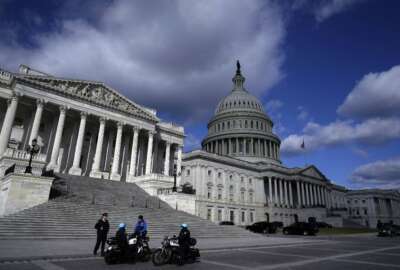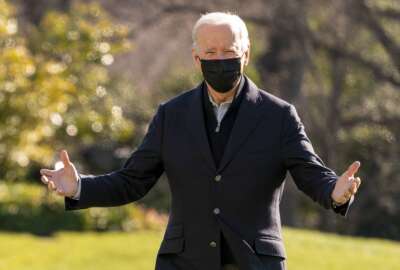USDA putting $100M to work to modernize key benefits program
Rebecca Piazza, a senior advisor at USDA, said American Rescue Plan Act funding is making the WIC program more attractive to parents and families.
The Agriculture Department is already seeing some of the benefits from its $100 million investment into one of its foundational programs.
USDA is using the funding from the American Rescue Plan Act to modernize systems that run the Women, Infants and Children (WIC) and using the corresponding data to expand the reach of the program.
Rebecca Piazza, a senior advisor for delivery for the Food and Nutrition Service at USDA, said the funding is making the WIC program more attractive to parents and families.

“We’ve been making a big emphasis on improving the customer experience of WIC, making it easier to shop with WIC benefits, making it easier to connect with the program and sign up, making it easier to participate in some of the wonderful benefits that like offers such as nutrition classes,” Piazza said in an interview with Federal News Network. “We’ve invested over $100 million in state technology modernization efforts and state program modernization efforts. Those have gone to things like improving the in store shopping experience, things like apps that help people check in the aisle whether or not a food is eligible for WIC rather than finding out when they get up to the scanner and go to checkout and use their benefits so that they can make sure that they’re buying the right food. Even things that aren’t technology things like shop along buddies who can help people understand the program while they’re in the grocery store, and help them become more proficient in using their benefits.”
Piazza said USDA also has been promoting easier ways to access the program such as promoting online applications and supporting new ways of using benefits, such as pilots for online shopping for WIC.
USDA thinking bigger
Like with many federal programs, the surge of funding let USDA make some sizable investments that were not possible under previous appropriations levels that is leading to more than just incremental improvements in enhancing how the agency delivers services.
Piazza said the American Rescue Plan Act is letting USDA “think bigger and tackle more far reaching improvements to the program.”
For example last May, USDA awarded $16 million in grants to 36 projects aimed at testing innovative outreach strategies to increase participation and equity.
As part of the fiscal 2024 spending bills passed by Congress on Friday and signed into law by President Joe Biden on Saturday, USDA will receive $7 billion for WIC, which is $1 billion more than what the program received in 2023.
For 2025, the Biden administration is asking for $7.7 billion.
“By investing in outreach and modernization, WIC would reach 800,000 more women,
infants, and children each month, providing vital nutrition assistance to nearly seven million individuals, up from 6.2 million in 2021,” the White House wrote in the budget request.
Piazza said before the funding bills passed that keeping WIC fully funded remained critical based on the most recent data from 2021 that shows USDA is only reaching about 51% of the eligible participants. She said the additional money could help reach nearly 6 million people who are missing out on the benefits of the program.
“We really want to reach as many women as possible with this program and see that as a big opportunity to expand the reach of WIC,” she said. “We do have some early eligibility estimates for 2022 and 2023 that are exciting because preliminary data for those years is showing that with participation is rising in most states. And we’re really excited about that because we want to see this program reach as many people as possible.”
CX driving change
One of the ways USDA is trying to reach more people is by better understanding the data and metrics of the programs that the agency boosted through the extra funding.
Piazza said through the grants, USDA is giving the states technical assistance since many of the programs have a longer running time over multiple years.
“I think a great example of some of the efforts that we’re setting up to go over multiple years is a recent grant that we made for data matching, so that we can connect people who are eligible to participate in Medicaid or in SNAP, and identify them and reach out to them with information about WIC, which they may not have heard about before, and let them know their streamlined ways for them to join the program,” she said. “That way we can target folks that are likely to be eligible for the program, and then give them that custom outreach in order to make them aware of the benefits and quickly connect them to it.”
Piazza said a lot of USDA’s effort to improve access to and the use of WIC is driven by the customer experience executive order the president signed in December 2021.
“We’ve been really seeking to understand by doing interviews, research and usability testing with program participants, as well as people who are eligible for the program and are not currently participating, to understand why not and what we might do as far as our delivery of the program in order to either help people understand this as a program for them, or to make it easier to interact with so that they’re interested in participating in the program,” she said. “We also are looking at choice and understanding that when someone is interacting with a program, like WIC, they have different interests and how they interact with it. Some people love to come in and show their baby off in the office and have that in office experience. Others are juggling jobs and other kids at home and that’s a bit more challenging so if they can do nutrition education, maybe virtually that’s something that they may choose. So looking at where we can provide options and really meet families where they are.”
Piazza said her office also is working on other priorities outside of WIC specifically. One is launching a new nutrition program called Summer Electronic Benefit Transfer (EBT), which is a new permanent nationwide program that will benefit more than 29 million children.
“This program will provide families with around $40 a month per child and food benefits that are delivered through an EBT card similar to the SNAP program. Families will be able to take this card and shop at eligible grocers and vendors, or even eligible grocers and vendors and buy food for their children during the summer,” she said. “This closes a significant gap because while we do offer summer meal programs, about only one in six children who are eligible for free and reduced price school meals are served by those summer meal programs because they are required going to a community center other site where there’s meals are delivered. By providing EBT cards, we’ll be able to reach families, maybe in rural areas or other places where accessing a summer meal site is not convenient, and really be able to have a really powerful new tool boards addressing child hunger in the summers.”
Copyright © 2025 Federal News Network. All rights reserved. This website is not intended for users located within the European Economic Area.
Jason Miller is executive editor of Federal News Network and directs news coverage on the people, policy and programs of the federal government.
Follow @jmillerWFED






